Thou shalt see me at Philippi - A Macedonian Journey (original) (raw)
 - Roman Thessalonica
(inscription celebrating Emperor Vespasian at Philippi)
- Roman Thessalonica
(inscription celebrating Emperor Vespasian at Philippi)
Four miles from Salonica are hot baths, the waters are only lukewarm; (..) these are probably those baths fom which Thessalonica was first called Therma, and gave the name of of Thermaicus to this great bay, which is now called the bay of Salonika; the city being situated about the north east corner of it. (..) Thessalonica is said to have its name from its foundress Thessalonica, sister of Alexander the great. Richard Pococke - A Description of the East, and Some Other Countries - 1745
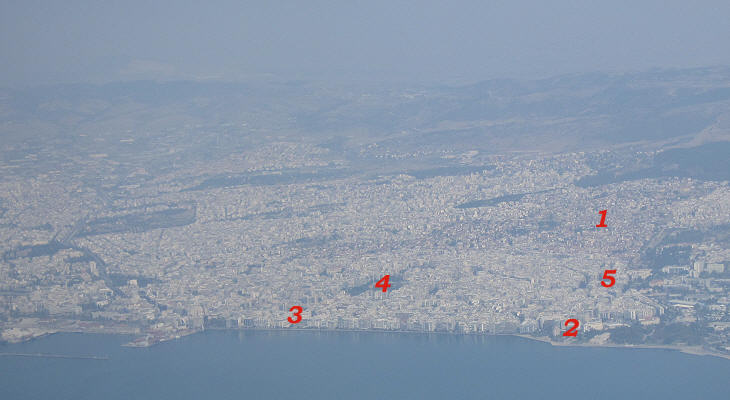
## Aerial view: 1) Acropolis, later the Muslim quarter; 2) White Tower (the Christian quarter lay between this tower and the Acropolis); 3) Jewish quarter; 4) Roman Market; 5) Rotunda (Mausoleum of Emperor Galerius)
(October 1807) Salonica, as the Italians and English name this city, is by the Turks called Selanik and by the Greeks Thessaloniki. Being situated in great part upon the declivity of a hill rising from the extremity of that noble basin at the head of the Thermaic gulf (..) and being surrounded by lofty whitened walls, of which the whole extent, as well as that of the city itself, is displayed to view from the sea, it presents a most imposing appearance in approaching on that side. William Martin Leake - Travels in northern Greece - 1835 Thessalonica was founded in 315 BC by Cassander, King of Macedonia, who enlarged an existing settlement known as Thermae and gave it the name of his wife, stepsister of Alexander the Great, who was so called to celebrate a victory (nike) over Thessaly, a region south of Mt. Olympus. Thessalonica acquired importance in 148 BC when it became the capital of the newly established Roman province of Macedonia. The Romans built Via Egnatia, a major road which linked the city with the Adriatic coast of Albania and from there through Brindisi and Via Appia to Rome (the main street of today's Thessalonica is Odos Egnatia). Roman Thessalonica consisted of an acropolis which was located south-east of a small bay, of a lower town with a large market and of the harbour which was further inland compared to the current coastline; this layout was very similar to that of Smyrna (today's Izmir). These two ports of the Aegean Sea have in common some recent events; they both experienced a very destructive fire (Thessalonica in 1917, Smyrna in 1922) and they both were greatly affected by the 1923 exchanges of population between Greece and Turkey: Thessalonica lost its Turkish citizens, Smyrna the Greek ones.
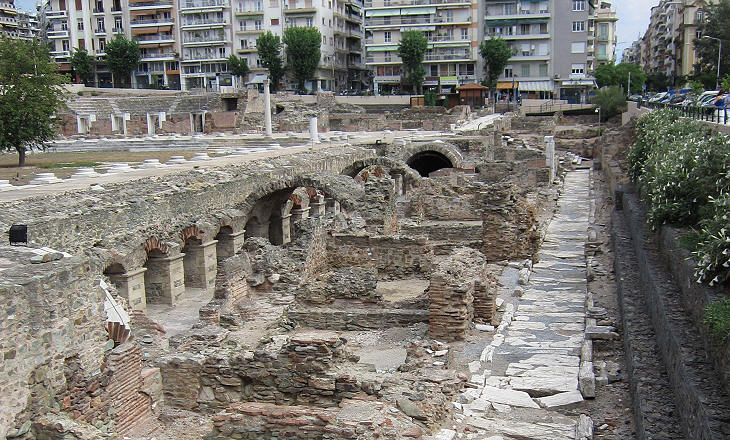
## Roman market/forum with a small odeon
After the 1917 fire Thessalonica was rebuilt and it significantly developed becoming the second largest city of Greece and its main manufacturing and trading centre; in recent years during excavations aimed at replacing small buildings with larger ones, remains of the Roman town were unearthed. They consist of a double portico which surrounded a large rectangular square having at one end an odeon, a small covered theatre; they are thought to have been built in the late Ist century AD.
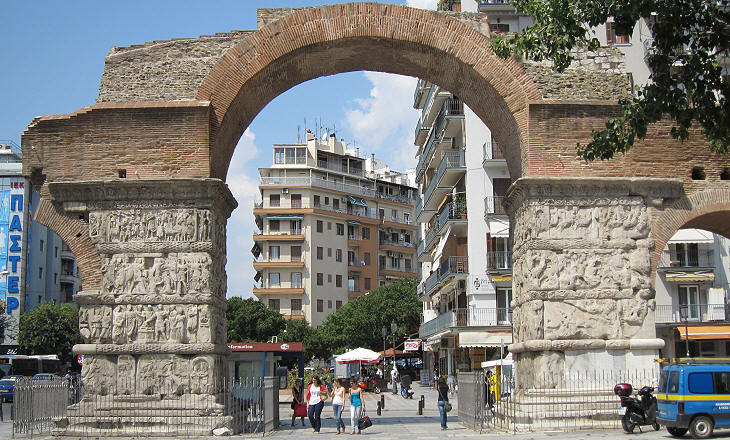
## Arch of Emperor Galerius
There are in the city some few remains of antiquity; one of the principal is a very grand triumphal arch much ruined, but in the perfection of the sculpture, and costness of the work, it seems to rival any arch that remains; it consisted of three arches built of brick and cased with marble. (..) One member of the cornish under the spring of the arch is worked with one row of leaves like the Corinthian order: There were niches in the fronts between the arches. (..) It is probable, that the upper part was adorned in proportion to the rest, but whatever ornaments there were they are now destroyed; as the arch seems to be low in proportion, it may be conjectured that there was another compartment of reliefs also covered by the earth. The shops and houses are built about it in such a manner, that it was difficult to take the measures, especially of the middle arch. Pococke The gate at the eastern end of the town, which had two smaller lateral arches annexed to it, now destroyed, consists of two piers 14 feet square, faced with stone, which were covered on all sides with a double range of figures in low relief, representing the sieges, battles, and triumphs of a Roman Emperor. (..) The arch which rests upon the piers is still more deprived of its facing, and is now a mere mass of Roman tile and mortar. Zosimus seems to give some support to the tradition which attributes this monument to [Constantine](Storia11.html#Ponte Milvio). Leake The most imposing monuments of Roman Thessalonica belong to the early IVth century when Galerius set his residence in the city; he was a general of Emperor Diocletian who in 293 was appointed Caesar(a sort of junior emperor in the frame of the Tetrarchy system) and married Valeria, Diocletian's daughter. He became Emperor in 305.

## Arch of Galerius: (above) Diocletian (left) and Galerius (right) make a sacrifice; (below) scenes of fighting which show elephants and lions
The piers all round were adorned with three compartments of reliefs one over another, as of same procession; the reliefs are four feet two inches deep and are divided from one another by other reliefs which are a foot broad and consist of running boughs and flowers; the reliefs are much defaced, but they have been cut in very great perfection, and the arch is said to be of the time of the Antonines. Pococke A great part of the piers are concealed by shops of the bazar, which cover all the lower parts of the figures on one side, and the whole of them on the other. Entering a bakehouse in the latter situation, I found the sculpture still more defaced than in other parts, but in none is it in good preservation, and the whole appears to have been of a very declining period of art. Leake In his role as Caesar Galerius had direct responsibility for most of the Balkan Peninsula, but between 296 and 299 he was involved in campaigns against the Sassanids who threatened the eastern provinces of the empire which were under Diocletian's jurisdiction. After an initial defeat Galerius managed to invade Persia from Armenia and then descended from Amida (today's Diyarbakir) along the Tigris River into Mesopotamia and conquered Ctesiphon, the Sassanid capital near today's Baghdad (it was the fifth time the Romans conquered that city).
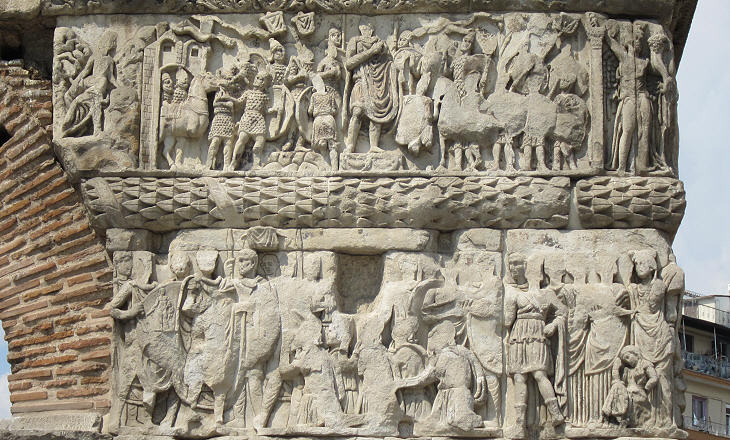
## Arch of Galerius: (above) Emperor Galerius delivers a speech (allocution); (below) captured enemies surrender
In 305 Diocletian retired and Galerius became Augustus (senior co-emperor) together with Constantius Chlorus, Constantine's father; in the following years Galerius repeatedly tried to become the sole emperor, but he eventually had to accept sharing the empire with Constantine and Licinius; the arch which celebrates his victories was probably built after Galerius became Augustus. The iconography of the remaining marble panels was inspired by the reliefs of Trajan's Column (the scenes of the allocution and of the enemies' surrender) and of a monument to Emperor Hadrian (the scene of the sacrifice). In all reliefs the face of Galerius has been erased or badly damaged, probably by the Christians who charged him with having instigated Diocletian's persecution. The image which appears in the background of this page shows a relief of the arch portraying Galerius on his horse, personally involved in a fight (in Trajan's Column the Emperor was never portrayed while taking part in a fight).
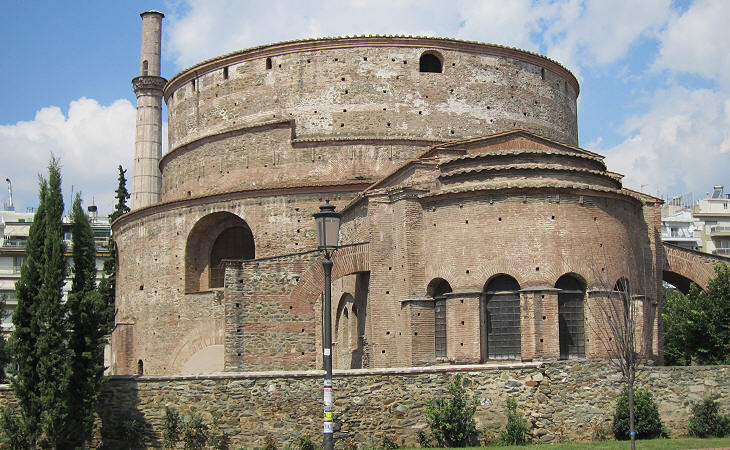
## The Rotunda
There are several mosques in the city which were formerly churches; that which carries the greatest mark of antiquity, is the rotundo, and if it was not an antient temple, it was certainly built when Christianity was first publickly established, though I imagine it to have been a heathen temple, and probably a pantheon; the walls are very thick, and built of good brick; the chapels round it are arched over with double arches of brick, excepting the two entrances to the west and south; there are in them oblong Square niches which appear like windows, and are now filled up; above these the wall is not, I suppose, so thick by twelve feet, and over every one of these apartments there is an arched nich. (..) The apartment opposite to the entrance is lengthened out to twenty-seven paces, and ends in a semicircle, which, if it was a temple, I suppose must have been added by the Christians for the altar. Pococke All the principal mosques were formerly Greek churches, and two of them were Pagan temples, which had been converted into churches. The most remarkable is that which is still known to the Greeks by the name of Eski Metropoli, an appellation employed also by the Turks. Hence it seems to have been, in the time of the Byzantine Empire, the cathedral church of the metropolitan bishop. It is a rotunda built of Roman bricks, with two doors, one to the south, the other to the west. The thickness of the walls below is 18 feet, their height about 50 feet, the diameter within, 80 feet: above these walls was a superstructure of slighter dimensions, the greater part of which, as well as the dome which crowns it, may perhaps have been added when the building was converted to the service of Christianity. It is lighted by windows in the middle height of the building, which in all is about 80 feet. Possibly these windows also are a Christian repair, the ancient temple having perhaps been lighted from the dome. Leake
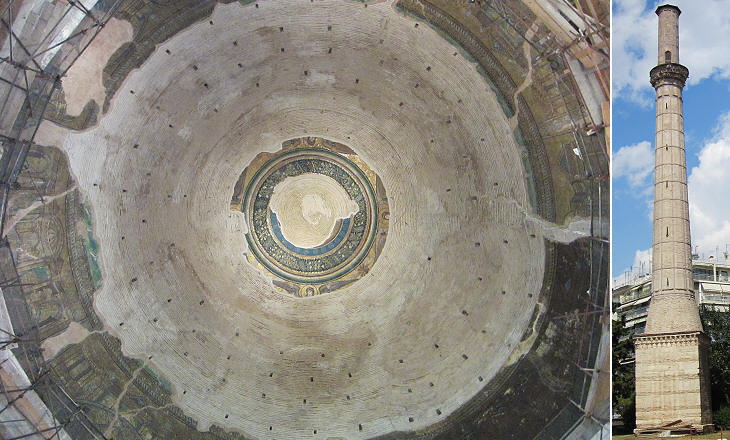
## The Rotunda: (left) interior of the dome; (right) minaret
Galerius built the Rotunda 150 ft northeast of the arch in alignment with its pillars; the purpose of this large circular building is uncertain, although the prevailing opinion suggests it should have been his mausoleum (similar to those of [Augustus](Vasi167.htm#Mausoleo di Augusto) and of Hadrian in Rome); it was turned into a church by the addition of an apse on its eastern side and it was dedicated to St. George, a very popular saint in Macedonia, also because its iconography is reminiscent of the Macedonian/Thracian Horseman, a local deity. The presence of a circular opening in the dome, similar to that of the Pantheon in Rome is a feature which could indicate that the Rotunda was meant to be a temple; the construction technique of the dome is also similar to that of the Pantheon; the fact that it never collapsed is particularly remarkable considering that the region of Thessalonica is subject to major earthquakes. The Ottomans turned the church into a mosque with the addition of an imposing minaret, the only one not to be pulled down or cut after the Muslim population left the city.

## Mosaics: (above) buildings; (below) decorative patterns
The cupola is adorned with mosaic work, appearing like eight frontispieces of very grand buildings, the perspective of which seemed to be very good. Pococke The inside of the dome is adorned with the representation of buildings and saints, in mosaic, interspersed with inscriptions which, as usual in Greek churches, explained the subjects, but are now too much injured to be decypherable, though the Turks have not destroyed any of these ornaments. Leake A mosaic decoration based on the depiction of large buildings can be noticed also in some earlier mosaics in Tunisia, later mosaics at Ravenna and in the Umayyad Mosque of Damascus.
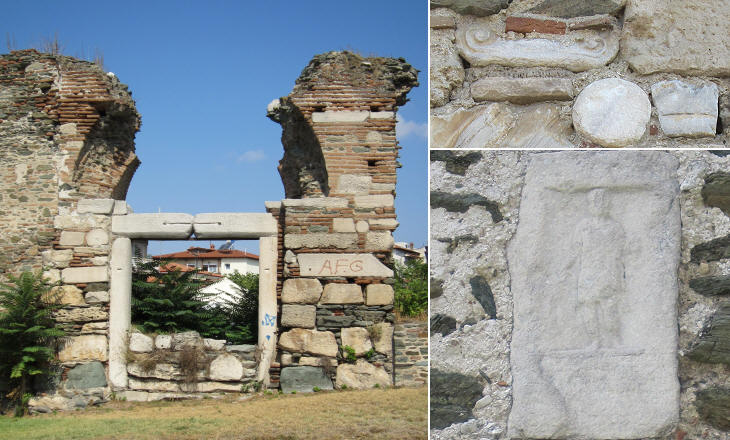
## Ancient materials (capitals, lintels, tombstones) incorporated into the walls
In many parts of the town, particularly at the fountains, sepulchral stones and inscribed stones are to be found. Wherever figures occur, their heads have, as usual, been destroyed by the Turks, nor is it easy to find an inscription that is perfect. Leake
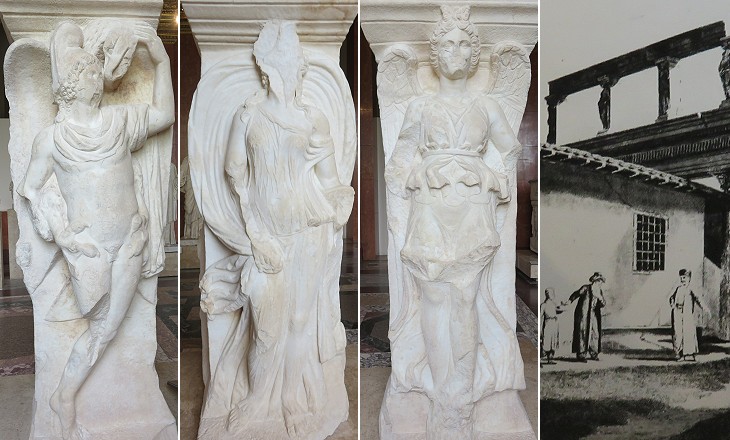
## Louvre Museum in Paris: statues portraying Ganymede, a goddess and a victory which decorated "La Incantada", a Roman building of the IInd - IVth century AD
Another piece of antiquity is the remains of a very fine Corinthian colonade; it consists of five pillars of Cipolino; the capitals are of exquisite workmanship; the pillars, two feet in diameter, are nine feet two inches apart; the frieze is fluted, and on the entablature is a sort of an Attic order of square pilasters with an architrave over it, the other parts of the entablature being taken away, if ever there were more; but the greatest beauty of this colonade are four alt-reliefs in both fronts, between the Attic pilasters, of a person as big as life: to the east is a Bacchus, Mercury, and two Victories; to the west Leda, a woman, a naked man, and a woman in profile, with something in her left hand held up; the sculpture of all of them is exceedingly fine: By this disposition one would also imagine, that this was a triumphal monument in an extraordinary taste, it being otherwise difficult to conceive how two fronts of such a colonade could appear to advantage. Pococke Near the main street, are the ruins of a portico with a double order of architecture. (..) This monument is in the house of a Jew, and is known in the Spanish dialect of the Jews by the name of Incantada, "the Enchanted," on the supposition that the figures are human beings petrified by the effect of magic. Its central position, and the nature of the construction, support the idea that it was connected with the ancient agora. Leake This puzzling monument was dismantled in 1865 and parts of it were shipped to Paris.
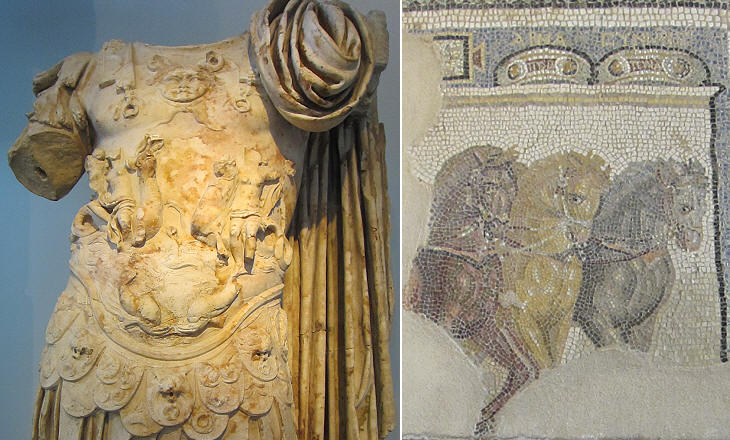
## Archaeological Museum of Thessaloniki: (left) statue of a Roman emperor (IInd century AD - see some statues in the Museum of Antalya): (right) detail of a mosaic found in a villa in the environs of the city; it most likely depicted the four horses of a race chariot
In 1869 an Archaeological Museum was inaugurated at Constantinople and some limits were placed on the export of works of art from the Ottoman Empire. The main focus of the modern Archaeological Museum of Thessaloniki is on the Macedonian past of the town and its region (see a map of it), but it houses also a number of exhibits of the Roman period.
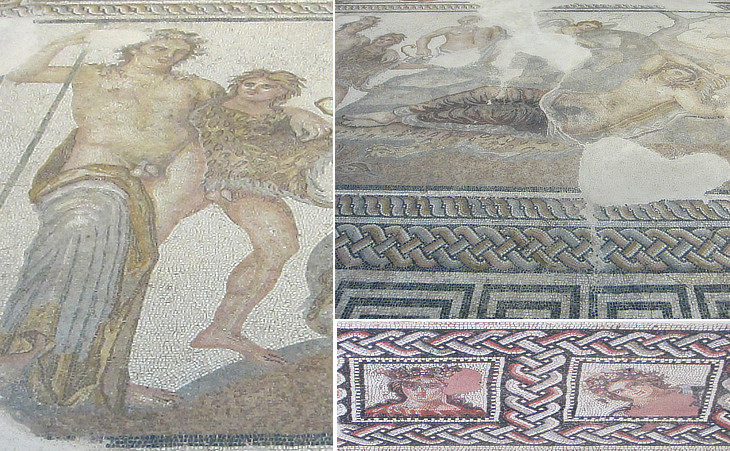
## Archaeological Museum - floor mosaics: (left and right-above) Dionysus and Ariadne at Naxos; (right-below) two of the [Four Seasons](Bardo.html#Four Seasons)

## Archaeological Museum: sarcophagus (IInd century AD); the lid shows a couple attending their funerary banquet and the box a fight of the War of Troy - see a page on Roman Funerary Rites and the manufacturing and trading of sarcophagi